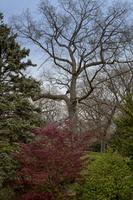This content is from a series created in partnership with Museum Services of the City of Toronto and Heritage Toronto. We gratefully acknowledge funding from the Ontario Ministry of Tourism, Culture and Sport, and the Department of Canadian Heritage.
Toronto Feature: High Park
"Family Bequest Preserves Rare Ecology"
It's a rare place in Toronto where you can experience the natural environment close to what it was hundreds, if not thousands, of years ago. High Park is one of them. The bequest of John and Jemima Howard of High Park to the city preserved one of the last remaining vestiges of oak savannah, which once dotted sandy regions of southern Ontario. About one-third of the park consists of open areas containing widely spaced black oaks, and a rich variety of rare prairie grasses and wildflowers. The High Park savannah's beauty caught the attention of members of the Group of Seven.
The delicate ecosystem is well adapted to the dry, sandy soils left by Lake Ontario's prehistoric predecessor, glacial Lake Iroquois, which covered the park 12 000 years ago. Historic maps and surveys reveal this area, stretching west to the Humber River, to have been sandy hills interspersed with low ponds and marshes. Modern development has erased much of those natural elements, and even in High Park, the creation of manicured parkland once threatened the natural savannah.
In the last few decades, however, new appreciation for the savannah areas and their unique ecosystems has led to better care. Most of the oaks in the park are now nearing the end of their life expectancy of 150 years and very few young oaks are growing to replace the older ones. Part of the reason for this is owing to human disturbance, including the prevention of periodic grass fires that help maintain an open forest floor and a rich variety of plant species.
Controlled fire is now used in the park to promote the regeneration of the black oak savannah. While plumes of smoke blowing through the park may alarm the uninformed, the fire releases seeds that are stored in the soil and burns off dead vegetation from the previous year, thereby allowing acorns to come in contact with the earth, and seedlings to receive more sun.
With these measures, conservationists are preserving both the rare ecology and the vision that John and Jemima Howard had for their bequest in 1873, the vision of a unique and magnificent natural park to be used in perpetuity by the citizens of Toronto.

 Partager sur Facebook
Partager sur Facebook Partager sur X
Partager sur X Partager par Email
Partager par Email Partager sur Google Classroom
Partager sur Google Classroom





